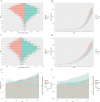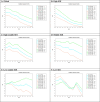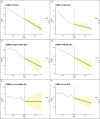Global, regional, and national burden of cardiovascular diseases attributable to metabolic risks across all age groups from 1990 to 2021: an analysis of the 2021 global burden of disease study data
- PMID: 40340811
- PMCID: PMC12060485
- DOI: 10.1186/s12889-025-22702-7
Global, regional, and national burden of cardiovascular diseases attributable to metabolic risks across all age groups from 1990 to 2021: an analysis of the 2021 global burden of disease study data
Abstract
Objective: The objective is to evaluate the temporal trends in the burden of cardiovascular diseases attributable to metabolic risk factors from 1990 to 2021 and to project the burden over the subsequent 30 years.
Methods: A joinpoint regression model was employed to estimate the annual percentage change in cardiovascular disease mortality attributable to metabolic risk factors, utilizing data from the Global Burden of Disease (GBD) 2021. An age-period-cohort analysis was conducted to evaluate the effects of age, period, and cohort. A frontier analysis was employed to investigate the correlation between the prevalence of cardiovascular disease attributable to metabolic risk factors and socio-demographic trends. An autoregressive integrated moving average (ARIMA) model was subsequently constructed to forecast future cardiovascular disease burden.
Results: Between 1990 and 2021, the global age-standardized mortality rate (ASMR) of cardiovascular diseases attributable to metabolic factors exhibited a consistent decline (Average Annual Percent Change (AAPC) = -1.28, 95% CI [-1.42, -1.14], P < 0.01). However, the absolute number of deaths increased from 8.326 million to 13.595 million. The most substantial reduction in ASMR was observed in the High Socio-Demographic Index (SDI) region (AAPC = -2.98, 95% CI [-3.10, -2.86], P < 0.01), whereas the reductions were relatively smaller in the Low-middle SDI and Low SDI regions. The ARIMA model predicts a decline in global cardiovascular disease mortality over the next three decades, with the most pronounced decrease anticipated in the high-middle SDI region and smaller declines expected in the middle SDI and low SDI regions.
Conclusion: Notwithstanding a global decline in age-standardized mortality and disability-adjusted life year (DALY) rates, the burden of cardiovascular diseases attributable to metabolic factors remains significant worldwide. Targeted interventions must be implemented without delay, particularly for males and populations in low and middle SDI regions, to mitigate the impact of metabolic factors on public health.
Keywords: Age-standardized mortality rate; Autoregressive integrated moving average; Average Annual Percent Change; Cardiovascular disease; Global Burden of Disease.
© 2025. The Author(s).
Conflict of interest statement
Declarations. Ethics approval and consent to participate: The GBD data are de-identified and publicly accessible, exempting the study from institutional ethics board review. Consent for publication: Not applicable. Competing interests: The authors declare no competing interests.
Figures







Similar articles
-
Global, regional, and national burden of breast cancer in young women from 1990 to 2021: findings from the global burden of disease study 2021.BMC Cancer. 2025 Jun 6;25(1):1015. doi: 10.1186/s12885-025-14416-1. BMC Cancer. 2025. PMID: 40481410 Free PMC article.
-
Temporal trend and attributable risk factors of cardiovascular disease burden for adults 55 years and older in 204 countries/territories from 1990 to 2021: an analysis for the Global Burden of Disease Study 2021.Eur J Prev Cardiol. 2025 May 12;32(7):539-552. doi: 10.1093/eurjpc/zwae384. Eur J Prev Cardiol. 2025. PMID: 39591503
-
Global, regional, and national burden of cardiovascular diseases in youths and young adults aged 15-39 years in 204 countries/territories, 1990-2019: a systematic analysis of Global Burden of Disease Study 2019.BMC Med. 2023 Jun 26;21(1):222. doi: 10.1186/s12916-023-02925-4. BMC Med. 2023. PMID: 37365627 Free PMC article.
-
Global, regional, and national burden of asthma and atopic dermatitis, 1990-2021, and projections to 2050: a systematic analysis of the Global Burden of Disease Study 2021.Lancet Respir Med. 2025 May;13(5):425-446. doi: 10.1016/S2213-2600(25)00003-7. Epub 2025 Mar 24. Lancet Respir Med. 2025. PMID: 40147466
-
Global trends and regional differences in mortality of cardiovascular disease and its impact on longevity, 1980-2021: Age-period-cohort analyses and life expectancy decomposition based on the Global Burden of Disease study 2021.Ageing Res Rev. 2025 Jan;103:102597. doi: 10.1016/j.arr.2024.102597. Epub 2024 Nov 29. Ageing Res Rev. 2025. PMID: 39617057 Review.
References
-
- Kahleova H, Levin S, Barnard ND. Vegetarian Dietary Patterns and Cardiovascular Disease. Prog Cardiovasc Dis. 2018;61(1):54–61. - PubMed
-
- Jagannathan R, Patel SA, Ali MK, Narayan KMV. Global Updates on Cardiovascular Disease Mortality Trends and Attribution of Traditional Risk Factors. Curr DiabRep. 2019;19(7):44. - PubMed
-
- Tsao CW, Aday AW, Almarzooq ZI, Alonso A, Beaton AZ, Bittencourt MS, Boehme AK, Buxton AE, Carson AP, Commodore-Mensah Y, Elkind MSV, Evenson KR, Eze-Nliam C, Ferguson JF, Generoso G, Ho JE, Kalani R, Khan SS, Kissela BM, Knutson KL, Levine DA, Lewis TT, Liu J, Loop MS, Ma J, Mussolino ME, Navaneethan SD, Perak AM, Poudel R, Rezk-Hanna M, Roth GA, Schroeder EB, Shah SH, Thacker EL, VanWagner LB, Virani SS, Voecks JH, Wang NY, Yaffe K, Martin SS. Heart Disease and Stroke Statistics-2022 Update: A Report From the American Heart Association. Circulation. 2022;145(8):e153–639. - PubMed
-
- Timmis A, Vardas P, Townsend N, Torbica A, Katus H, De Smedt D, Gale CP, Maggioni AP, Petersen SE, Huculeci R, Kazakiewicz D, de Benito Rubio V, Ignatiuk B, Raisi-Estabragh Z, Pawlak A, Karagiannidis E, Treskes R, Gaita D, Beltrame JF, McConnachie A, Bardinet I, Graham I, Flather M, Elliott P, Mossialos EA, Weidinger F, Achenbach S. European Society of Cardiology: cardiovascular disease statistics 2021. Eur Heart J. 2022;43(8):716–99. - PubMed
-
- Rout A, Duhan S, Umer M, Li M, Kalra D. Atherosclerotic cardiovascular disease risk prediction: current state-of-the-art. Heart (British Cardiac Society). 2024;110(15):1005–14. - PubMed
MeSH terms
LinkOut - more resources
Full Text Sources
Medical

